The first cross-border airport bridge between Mexico and the USA has opened at Tijuana International airport, sparking what officials hope will be a surge in traffic.
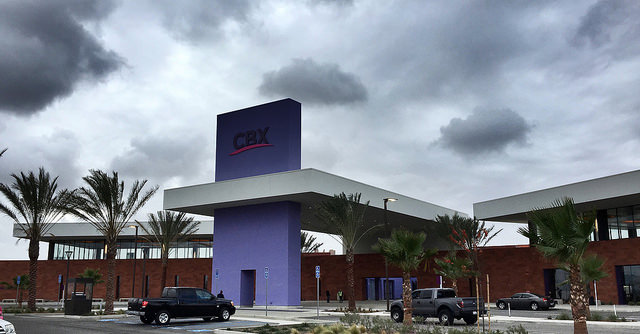
Edward Russell
The 119m (390ft) Cross Border Xpress (CBX) bridge, connecting a new privately-run terminal in the USA with the Tijuana airport terminal, opened to its first passengers on 9 December.
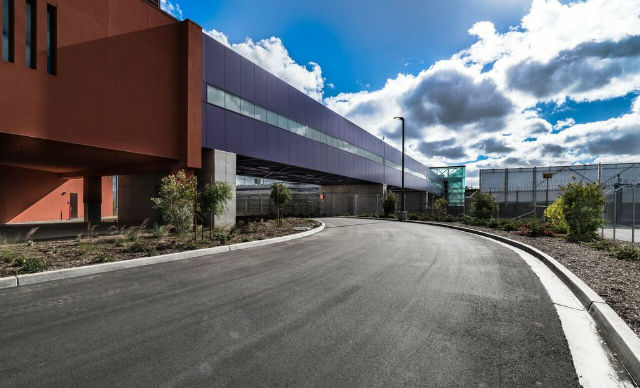
CBX
“There’s a great expectation from the Mexican carriers on what they can get from this facility,” Tomas Ramirez Vargas, chief commercial officer of operator Grupo Aeroportuario del Pacifico (GAP), told Airline Business at World Routes in September.
Aeromexico has "high expectations" of the new CBX terminal and bridge and sees it driving a roughly 20% increase in traffic at Tijuana airport over the next five years, a spokesman says. The Mexican flag carrier is targeting both visiting friends and relatives traffic as well as business travellers, including a new VIP lounge for the latter.
"[Aeromexico] is well-suited to manage the increasing demand and frequencies, both on international as well as domestic flights, or with new international markets from Tijuana airport," they say.
GAP anticipated a nearly 30% increase in seats in December from last year, said Ramirez in September. Innovata FlightMaps Analytics shows seats up nearly 26% to 327,189 at Tijuana this month.
The airport’s largest airline Volaris has increased capacity nearly 30%, Interjet is up more than 22% while Aeromexico is down 13% compared to a year ago, Innovata shows.
VivaAerobus added Tijuana to its growing network in November and plans to grow further at the airport in 2016.
Tijuana airport passenger traffic increased 8.7% to 4.29 million during for 11 months ending in November, GAP data shows. It is the operator’s second busiest airport after Guadalajara.
In 2016, GAP plans to open an eight-gate terminal expansion at the airport to handle the anticipated traffic growth, says Ramirez.
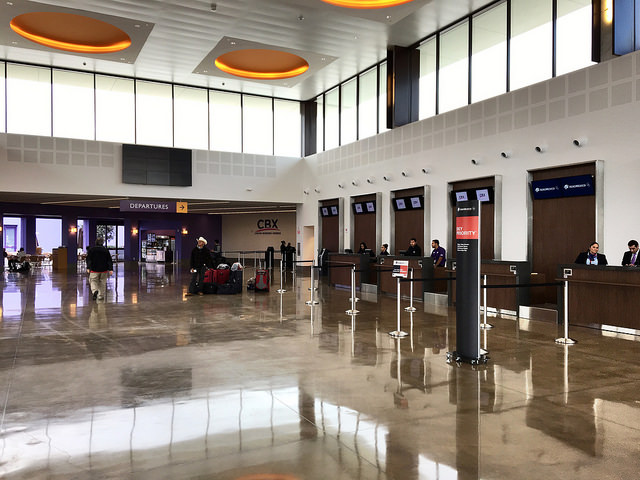
Edward Russell
Aeromexico and Volaris already have counters in the CBX terminal where passengers can check-in and change flights.
Aerero Calafia, Interjet and VivaAerobus will open check-in facilities in the CBX terminal in the “next couple of months”, says Elizabeth Brown, chief commercial officer of CBX, during an interview in the new terminal.
She repeatedly declines to comment on how many passengers CBX anticipates will use the facility in the first year or how many it handled on its first day, except to say they are “happy with the number of passengers coming through”.
A steady stream of passengers departed through CBX when Flightglobal visited on its third day of operations, 11 December.
“In time, we think there will be some stimulation from the implementation of CBX,” says Brown. “We’re changing the travel patterns for people who have crossed the border for years. We’re changing a habit.”
She points to seasonal migrant workers in the USA that have taken buses to and from the Tijuana airport to their jobs along the US west coast for years as an example. CBX is working with bus companies to have these travellers use the new terminal.
About half of all of the passengers using the Tijuana airport cross the Mexico-USA border at some point, she adds.
Moving both bus traffic, as well as the countless people who cross the border and take taxis to Tijuana airport, should reduce congestion at the two border crossings in the San Diego-area, says Brown.
The new US terminal is designed to handle up to two million passengers annually and has room to expand.
FIRST OF ITS KIND
The bridge is first of its kind in the USA and one of just a few bi-national airport facilities in the world. EuroAirport Basel-Mulhouse-Freiburg and Geneva airports between France and Switzerland are the best known of such facilities.
CBX differs somewhat from its European counterparts. Brown describes it as essentially a land border crossing between Mexico and the USA that is limited to just airport passengers.
Passengers departing from the USA can arrive at the CBX terminal, check-in and purchase a pass to cross the bridge up to 24h before their flight. They then proceed to document check, pass through a soon-to-open duty free shop and use the bridge to cross the border to Tijuana where they clear Mexican passport control and enter the pre-security area of the airport.
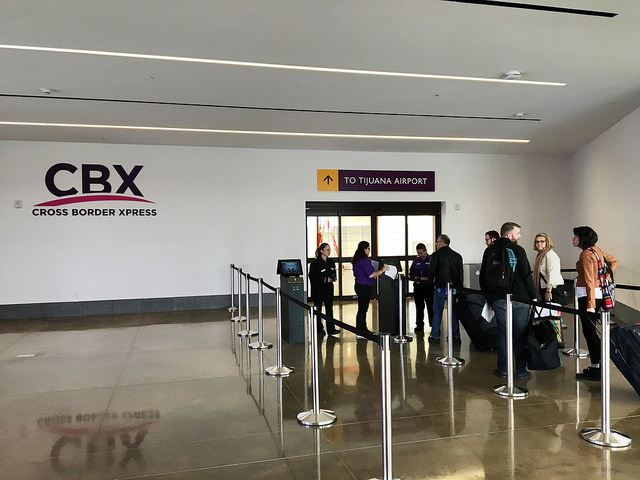
Edward Russell
Once in the terminal at Tijuana airport, they can drop their bags and clear security or spend a day in the city before catching their flight, says Brown.
The return trip to the USA is a bit stricter. Passengers must opt to use the CBX bridge before exiting the secure baggage claim area within 2h of their arrival. The process then happens in reverse with their bridge pass checked, the short walk across the bridge to US passport control, after which they exit to the arrivals hall.
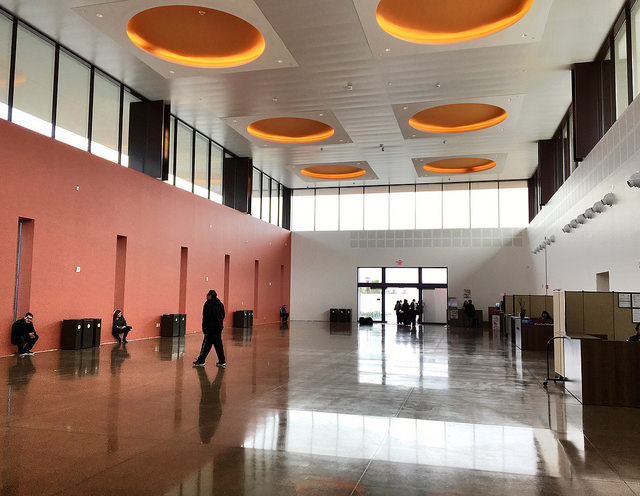
Edward Russell
Passengers must have a pass to cross the bridge, with discounts available for children 12 and under and anyone over 65 years in age. The cost is $18 each direction per passenger.
CBX passes are currently available for sale in the US and Tijuana terminals as well as online, says Brown. Aeromexico and Volaris will begin selling them as additional options with ticket purchases on their websites in the next few weeks, she adds.
Down the road, the terminal operator is working with IATA to get its own code so that passengers can book flights directly to CBX with the bridge fee included, says Brown.
This has precedent at EuroAirport, which has three IATA codes: EAP as the neutral code, BSL for Switzerland and MLH for France.
COMPETITION
“We don’t see ourselves in competition with them,” says Brown, when asked whether CBX anticipates pulling Mexico-bound traffic from San Diego International airport just 37km to the north.
She points to the fact that Tijuana is primarily a domestic airport, with many Mexican Americans already using it over San Diego for trips to visit friends and family.
CBX hopes to work with San Diego airport officials in the future. For example, possibly implementing a shuttle between the airport and the cross-border terminal to facilitate US domestic-to-Mexico connections between San Diego and Tijuana, says Brown.
Hampton Brown, director of air service development at San Diego airport, called the relationship with Tijuana airport “symbiotic” in a 2013 interview, acknowledging that the airport had less service to Mexico than comparably sized cities due to the proximity of the Mexican facility.
That symbiotic relationship continues to exist today, says a spokeswoman for the San Diego airport.
"Many San Diegans already use Tijuana International airport for flights within interior Mexico and, similarly, the citizens of Tijuana use SAN for flights to US interior cities and some international points," she says. "The cross border terminal is now an option to facilitate this travel already occurring."
Competition does exist between the San Diego and Tijuana airports. Routes to Mexico from the former primarily serve US leisure and business travellers with nonstops to Guadalajara, San Jose del Cabo (Los Cabos), Mexico City and Puerto Vallarta. Tijuana offers nonstop flights to all of those cities and at least 30 more, Innovata shows.
In addition, Tijuana is working to land new service to Asia on a Chinese or Korean carrier, says Ramirez. Such a service that could draw potential long-haul passengers away from San Diego, whose only nonstop to Asia Pacific is to Tokyo Narita.
Tijuana already boasts an Aeromexico nonstop to Shanghai Pudong.
In an interesting move, both Aeromexico and its codeshare partner Delta Air Lines plan to add new service between San Diego and Mexico. The former plans to launch Guadalajara and Mexico City service in January and the latter seasonal Los Cabos service from later in December.
Aeromexico flies to both Guadalajara and Mexico City from Tijuana, while three carriers – Alaska Airlines, Spirit Airlines and Volaris – offer service between San Diego and Tijuana and Los Cabos, Innovata shows.
Brown at CBX says any airline is welcome in the new terminal, even Delta as they seek to implement an immunised joint venture with Aeromexico on Mexico-USA flights.
Source: Cirium Dashboard
















